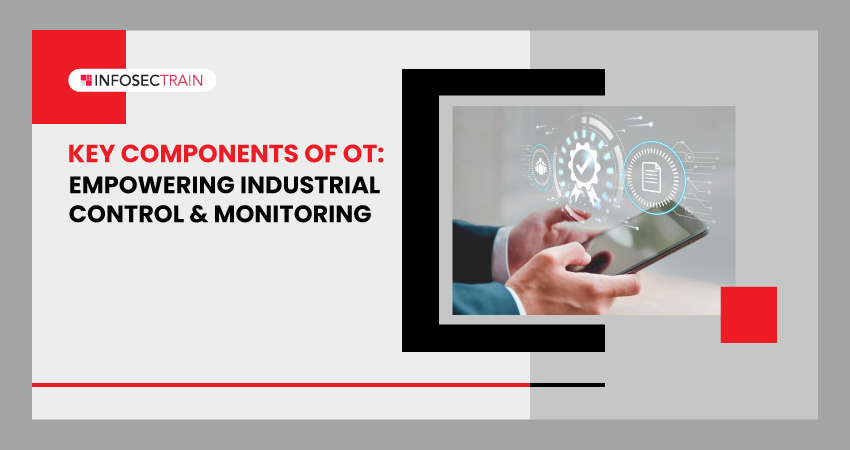Key Components of OT: Empowering Industrial Control & Monitoring
Operational Technology (OT) drives the efficiency and reliability of industrial processes, encompassing a range of components that work harmoniously to control and monitor critical operations. This blog discusses the fundamental components of OT, shedding light on their significance, specific features, and applications.

Programmable Logic Controllers (PLCs):
PLCs are the workhorses of industrial automation and control systems. Designed to withstand challenging environmental conditions, including extreme temperatures and exposure to contaminants, PLCs offer exceptional reliability. They comprise a Central Processing Unit (CPU), input/output (I/O) modules, memory, and communication ports.
PLCs are highly flexible and customizable, making them suitable for various industrial applications. For instance, PLCs automate assembly lines in manufacturing plants, precisely control robotic machines, and optimize wastewater treatment processes for enhanced environmental sustainability.
Distributed Control Systems (DCS):
DCS provides comprehensive control and monitoring capabilities across complex, continuous process industries. DCS enables real-time management of multiple variables by utilizing dedicated controllers dispersed throughout a plant or control area.
With advanced control algorithms, data logging, and alarm management features, DCS is essential in critical infrastructures. Petrochemical plants rely on DCS to efficiently control chemical processes, oil and gas industries utilize DCS for remote monitoring of drilling operations, nuclear power plants employ DCS for safe and reliable power generation, and water management systems use DCS to distribute and treat water resources efficiently.
Supervisory Control and Data Acquisition (SCADA) Systems:
SCADA systems bridge the gap between physical processes and digital control, providing real-time monitoring and control capabilities. SCADA systems offer a holistic view of industrial processes by integrating sensors, data acquisition devices, Programmable Logic Controllers (PLCs) or Remote Terminal Units (RTUs), supervisory computers, and communication networks. They collect data on parameters such as temperature, pressure, flow rate, and more, enabling operators to make informed decisions.
SCADA systems find applications in various industries, including energy distribution, manufacturing, and transportation. For instance, they monitor and control power grids, optimize production lines in manufacturing facilities, and manage traffic flow in intelligent transportation systems.
Human-Machine Interface (HMI):
Human-Machine Interface (HMI) is an interactive platform for operators to monitor and control industrial processes. It visually represents the system, displaying real-time data, control panels, and alarms. Operators can easily monitor process status, adjust control parameters, and receive notifications for efficient troubleshooting. HMIs also offer data analysis and reporting tools, empowering operators to optimize process performance.
Examples of HMI applications include:
- Managing complex assembly lines in automotive manufacturing
- Controlling power generation and distribution in energy plants
- Overseeing operations in transportation systems
Industrial Networks:
Industrial networks form the backbone of OT, enabling seamless connectivity and communication among various components. These networks employ wired and wireless technologies and utilize industrial protocols such as Modbus, Profibus, or Ethernet/IP. Industrial networks ensure reliable and secure data transmission between PLCs, HMIs, sensors, and other devices within the OT system. They are crucial for maintaining uninterrupted control and monitoring of industrial processes, improving overall system performance and reliability.
Final Words:
The components of OT, including Programmable Logic Controllers (PLCs), Distributed Control Systems (DCS), SCADA systems, Human-Machine Interfaces (HMIs), and industrial networks, form a powerful ecosystem for industrial control and monitoring. Each component plays a vital role in automating processes, optimizing performance, and ensuring the reliability and safety of critical operations. By understanding and harnessing the potential of these components, organizations can unlock the full power of Operational Technology.
Elevate your knowledge and skills in OT/ICS Security with InfosecTrain’s comprehensive training programs. Explore our OT/ICS Security Foundation Training to deeply understand the components, architecture, tools, technologies, and industry best practices.
Continuous learning and upskilling are crucial for staying ahead in an ever-evolving industrial landscape. Embrace the transformative potential of Operational Technology and shape a safer, more efficient future.







 1800-843-7890 (India)
1800-843-7890 (India)